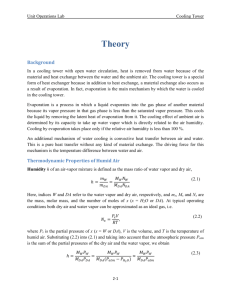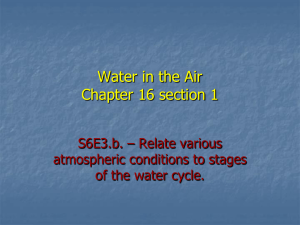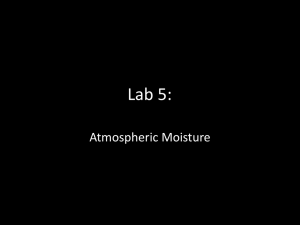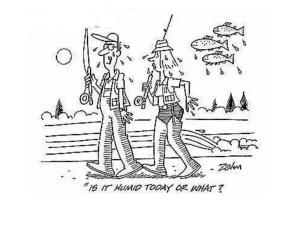CM4120CoolTowerLecture
advertisement
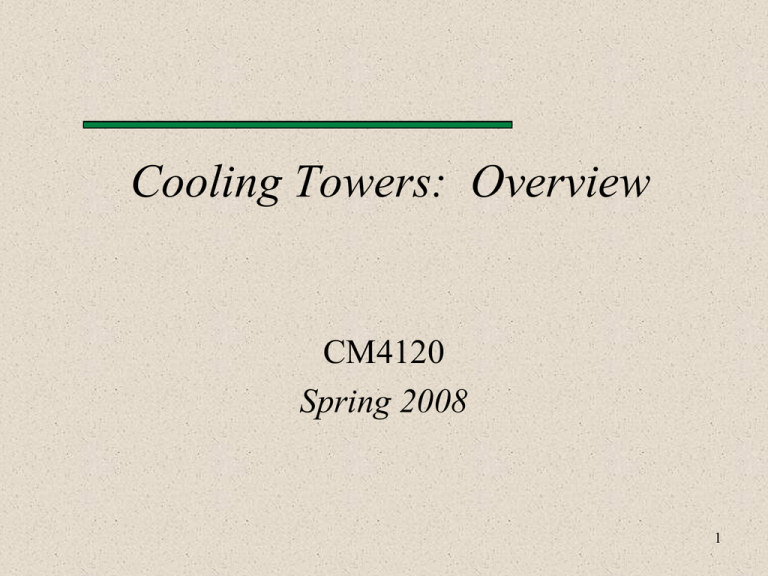
Cooling Towers: Overview CM4120 Spring 2008 1 Topics Introduction Definitions Operating Conditions Basic Components Water Cooling Systems Types 2 Introduction Boxed shaped collection of multilayered wooden slats Air flow breaks up water as it falls Design ensures good contact between water and air Used to remove heat from water 3 Key Definitions Wet-bulb temperature = air temperature measured by a wet-bulb thermometer – simulates effect of evaporative cooling Dry-bulb temperature = air temperature measured by a dry-bulb thermometer Approach = difference in wet-bulb temperatures between inlet and outlet called “the approach to the tower” Latent heat = heat associated with change in state of matter (e.g., liquid to gas phase) 4 Operating Conditions 10-20% of heat (sensible heat) removed from contact between water and air 80-90% of heat removed following evaporation Evaporation is most critical factor affecting tower efficiency! 5 Operating Conditions Factors which affect cooling tower performance: – – – – – – relative humidity Let’s discuss these! temperature wind velocity tower design water contamination equipment problems (pump failure) 6 Basic Components Water distribution system = includes header which distributes (sprays) water from top of tower over splash bars Fan = induced and forced draft towers use fans to push or pull air Air intake louvers = louvers on side of towers which direct air into tower (fixed or movable) Water basin = collects water at bottom of tower prior to discharge 7 Basic Components fill = material inside a tower which redirects air flow and water column = wooden or metal post which supports tower stack = hyperbolic towers and chimney towers have huge stacks located at top make-up water = water which is added due to evaporation and blowdown splash bars = used to redirect the downward flow of water 8 Parallel vs. Series Flow 9 Classification of CTs By direction of air flow – crossflow (airflow is horizontal ) – counterflow (airflow is vertical) designs By how the air flow is produced – naturally (hyperbolic or chimney towers) – mechanically (forced draft or induced draft) 10 Induced Draft, Cross Flow CT 11 Atmospheric Cooling Tower (Natural Draft) Use natural forces (wind) to move air through CT Air flows in through the sides, and out the top Drift eliminators on the top 12 Hyperbolic Cooling Tower Also called chimney CT Often seen at power plants Very high flowrates Air flows up, creating a draft 13 Forced Draft Cooling Tower Fans used to create a draft Air forced in the bottom, and flows out the top Typically solid sides Some recirculation of air possible, harming efficiency 14 Induced Draft Cooling Towers Fans located at the top of the CT Lifts air out of the CT, preventing recirculation Probably the most common type used in chemical plants and refineries 15 Troubleshooting Water dissolves many things (especially hot water!) Water is cooled and results in deposits in tower Solids concentrate in cooling tower basin Trivia Question: Are Cooling Towers equipped with automatic sprinklers? 16 Problems Faced by Operators Scale formation suspended solids form deposits Corrosion electrochemical reactions with metal surfaces Fouling - due to silt, debris, algae Wood decay - fungi 17 Water Composition Control Suspended solids levels checked by operators (ppm) Measured values compared to make-up water concentrations Problem controlled by “blowdown” (i.e., old water replaced with new) Note: 100 ppm = 100 lbs. suspended solids/1,000,000 lb water 18 Water Composition Control (Solutions) Scale formation – remove scale forming solids with softening agents – prevent scale forming materials by addition of chemicals – precipitate scale for removal 19 Water Composition Control (Solutions) Corrosion – add chemical inhibitors (adds thin film to metal) Fouling – use filtering devices – use dispersants with filtering devices Wood decay – use biocides (chlorine or bromine) 20 Water Testing (by Operators) pH of water total dissolved solids (TDS) inhibitor concentration chlorine or bromine concentration precipitant concentration filter and screen checks temperature and humidity 21 Humidity Measurements 22 Humidity -- Background Humidity is the amount of water vapor in the air Humidity is described in different ways – "relative humidity," which is the term used most often in weather information meant for the public – Relative humidity is the amount of water vapor in the air compared with the amount of vapor needed to make the air saturated at the air's current temperature Dewpoint temperature gives a much better estimate of the amount of moisture actually present in the air – very important in determining precipitation amounts and even how comfortable you feel 23 Definitions Absolute humidity: Mass of water vapor in a given volume of air( i.e., density of water vapor in a given parcel, usually expressed in grams per cubic meter) Dewpoint: Temperature air would have to be cooled to in order for saturation to occur (Assumes there is no change in air pressure or moisture content of the air). 24 Definitions Wet bulb temperature: Lowest temperature that can be obtained by evaporating water into the air at constant pressure. Name comes from the technique of putting a wet cloth over the bulb of a mercury thermometer and then blowing air over the cloth until the water evaporates. Since evaporation takes up heat, the thermometer will cool to a lower temperature than a thermometer with a dry bulb at the same time and place. Wet bulb temperatures can be used along with the dry bulb temperature to calculate dew point or relative humidity. 25 Definitions Relative humidity: The amount of water vapor actually in the air divided by the amount of water vapor the air can hold. Relative humidity is expressed as a percentage and can be computed in a variety of ways. One way is to divide the actual vapor pressure by the saturation vapor pressure and then multiply by 100 to convert to a percent. 26 Sling Psychrometer 27 Humidity Determination From wet and dry bulb temperatures Use psychrometric charts – find intersection of wet and dry bulb temperature lines – can read humidity from chart (y-axis) 28 END LECTURE! 29


